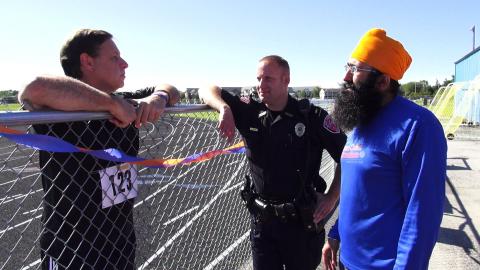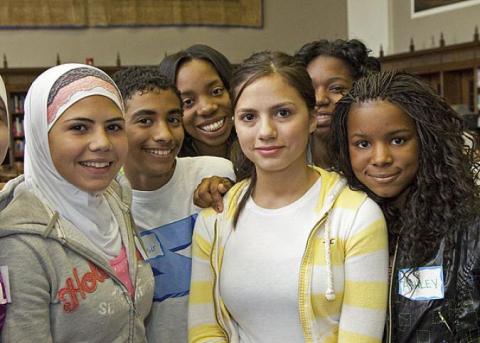By Patrice O’Neill, Not In Our Town CEO and Executive Producer
Dr. Becki Cohn-Vargas, Not In Our School Director
In his recent New York Times op-ed, "White, Bigoted, and Young: The Data of Hate," Harvard economist Seth Stephens-Davidowitz analyzes thousands of user profiles on Stormfront, the most popular white supremacist website in the United States. His findings paint a surprising—and disturbing—portrait of who joins a hate forum.
The most common age when people become Stormfront members is 19. Stormfront users are news and political junkies, and about 30 percent of the site’s members are female. Stormfront’s highest per capita membership is in the Pacific Northwest. And bias against Jewish and Black people are mentioned most in Stormfront user profiles.
At the end of his report, Stephens-Davidowitz says that despite his extensive research, he still doesn’t know why people join groups like Stormfront, or what can be done about it. But, fortunately, there is hope. There are things each one of us can do to stop hatred, and promote safety and inclusion for everyone.
For over two decades at Not In Our Town, we’ve made films about people all over the United States who are finding new ways to address bias, intolerance, and bullying. Here are five key lessons we’ve learned from remarkable everyday heroes who have faced down hate, and spoken up for their neighbors—and you can use them in your community:
1. Face the dangers of hate, and be aware that it exists in our society.
Violent, hateful outbursts like the anti-Semitic killings at Jewish institutions outside Kansas City, the deadly attack at the Sikh Temple of Wisconsin, and the 200,000+ hate crimes that occur each year are dramatic reminders that bigotry is a real and dangerous threat. People from communities where hate hasn’t hit home, or individuals who may not experience everyday prejudice, may assume that intolerance isn't a problem. When young people express hateful or intolerant messages, the response that they are “just being kids” sends a message that the community accepts this behavior. But people who have experienced hate in their towns have learned that facing these issues can bring residents together. As Montana State Representative Margaret MacDonald, a leader in the original Not In Our Town movement in Billings, Montana, shares in these guiding principles for confronting hate, by acknowledging bigotry, reaching out, and standing together, “the whole community is strengthened and relationships are built up.” Police departments can also play a vital role in hate crime prevention and response.
2. Reach out to young people before hate draws them in.
If the largest group of white supremacists and anti-Semites on Stormfront are 19-year-olds, we need to redouble efforts to reach our youth. We must give young people opportunities to take the lead in identifying problems, and encourage them to speak out when bigotry surfaces. Though it’s distressing to learn about youth on Stormfront, there are thousands of young people around the country who are working to create inclusive communities and schools—like these young Not In Our School leaders who shared their strategies for standing up to hate. It’s up to us to listen, and to support their positive efforts.
3. Create environments that promote compassion and empathy.
In his book My Life After Hate, former racist skinhead Arno Michaelis shares how alienation and a search for belonging pushed him into the white supremacist movement. Learning how to look at the world through other peoples’ eyes is an antidote to the sense of separation that can fuel intolerance. Some schools, like Grimmer Elementary in Fremont, CA, create kindness campaigns like “Leaving a Positive Footprint,” to help children explore the impact of bullying and practice compassion. Campaigns like Teaching Tolerance’s Mix It Up at Lunch Day encourage young people to move out of their comfort zones, cross social boundaries, and learn about each other.
4. Recognize and honor differences.
When it comes to diversity, it can be tempting to say that we’re “colorblind” to our differences. However, the sad reality is that racial divisions haven’t gone away, and neither children nor adults are blind to the things that make us different. Ignoring race or culture can also dismiss the real lived experiences of intolerance that many people face each day. Being connected to others and feeling a sense of belonging is a key human need. Identity-safe environments are spaces that help people of all backgrounds to feel a sense of belonging and have a voice. As an example, immigrant students from Newcomers High School in Long Island City, NY and middle schoolers from Manhattan came together to share their stories, connect, and understand immigration on a personal level.
5. Be open to having hard conversations.

When discussing racism, bigotry, and other kinds of intolerance, strong emotions can emerge. Having a candid conversation about these issues can bring tensions to light and help people find common ground. Our video What Do You Say to “That's So Gay”? depicts a teacher artfully navigating a difficult discussion in his classroom. He creates an environment where students feel free to speak up and contribute. To open community dialogue about bias and prejudice, Not In Our Town also offers films and discussion guides. Additionally, Public Conversations Project features a guidebook for facilitating constructive conversations on divisive topics.
Reaching the 19-year-olds who are ready to click into hate requires action from all of us. But we don’t have to wait for a horrific incident to do something. When we help one another, accept one another, and learn from one another, our actions create a force that is stronger than violence and hatred. And together, we can move toward a world of safety, acceptance, and respect for everyone.
Learn more about solutions and how to stop hate, together on NIOT.org.
Add new comment